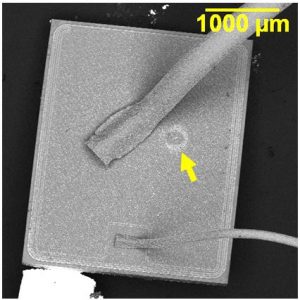
BSE SEM image of BGA microsection.

The entire interface fractured between the Ni-Sn intermetallic layer and the Ni-P of the ENIG board pad. This is the corner ball where warpage strains are at maximum typically.

Evidence of “hyper-etching” of the Ni-P grain boundaries, which is a symptom of black-pad-syndrome.

This is a recent example of “hyper-etching” of the Ni-P grain boundaries on an ENIG finished PWB that could be described as moderate relative to the previous example. This is the fracture surface of the PWB pad where a BGA was sheared off in what we refer to as “pry & SEM” evaluation. The phosphorus concentration at the fracture surface was determined to be 17.4 wt%, which is elevated compared with the expected 7 – 9 wt% phosphorus for medium phosphorus electroless-nickel. The elevated phosphorus and brittle fracture at the Ni-P/Ni3Sn4 interface are consistent with black pad syndrome, though this appeared to be a marginal case.
Check out SEM Lab, Inc. to learn more.



















